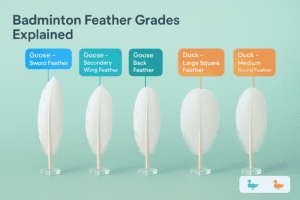Introduction to Strategy in Badminton
Badminton is not just about physical agility and power; it’s a game of strategy and mental acuity. Mastering the strategic aspects of badminton can give you a significant edge over your opponents. From understanding the basics to implementing advanced tactics, strategic play is essential for success on the court. In this comprehensive guide, we delve into the strategies that can help elevate your game, drawing on tips from professional players and coaches.
Understanding the Game’s Fundamental Tactics: Serve, Receive, and Court Positioning
Serve
The serve is the starting point of every rally and can set the tone for the point. Effective serving strategies include:
- Low Serve: Keeps the shuttlecock low over the net, forcing your opponent to lift it and giving you the chance to attack.
- Flick Serve: Used sparingly to surprise your opponent, sending the shuttlecock high and deep into their court.
- Drive Serve: A fast, flat serve aimed at catching your opponent off guard.
Receive
Receiving serves effectively involves anticipating the type of serve and positioning yourself correctly:
- Ready Stance: Stay light on your feet with knees slightly bent, ready to move in any direction.
- Shot Selection: Depending on the serve, choose between a net shot, lift, or drive to gain the upper hand in the rally.
Court Positioning
Good court positioning is crucial for maintaining control and dictating play:
- Base Position: Return to a central position after each shot to cover the court effectively.
- Front and Back: In doubles, one player typically covers the front while the other covers the back, optimizing court coverage.
- Side-to-Side: In singles, lateral movement is key to reaching shots on either side of the court.
Advanced Strategies: Deception, Speed, and Power Play
Deception
Deceptive shots can confuse your opponent and create openings:
- Fakes and Feints: Pretend to hit one type of shot, then change at the last moment.
- Disguised Shots: Use similar preparation for different shots, making it hard for opponents to anticipate your moves.
Speed
Speed is a vital component in badminton, affecting both offense and defense:
- Fast Rallies: Keep the shuttlecock moving quickly to pressure your opponent.
- Quick Returns: React swiftly to intercept shots and maintain the pace of play.
Power Play
Powerful shots can end rallies quickly and put opponents on the defensive:
- Smashes: Aim for steep angles to make returns difficult.
- Drives: Fast, flat shots that keep your opponent pinned to the backcourt.
Reading Your Opponent: Anticipation and Adaptation
Understanding and anticipating your opponent’s moves is crucial for strategic play:
Anticipation
- Observation: Watch your opponent’s body language and racket position to predict their next shot.
- Pattern Recognition: Identify patterns in their play to anticipate likely responses.
Adaptation
- In-Game Adjustments: Be flexible and adjust your strategy based on your opponent’s strengths and weaknesses.
- Exploiting Weaknesses: Target areas where your opponent is less comfortable, such as their backhand or movement to a specific part of the court.
Mental Game: Focus, Concentration, and Pressure Management
The mental aspect of badminton is as important as physical skills:
Focus
- Stay Present: Concentrate on the current rally without dwelling on past mistakes or future points.
- Routine: Develop a pre-serve routine to focus your mind and prepare for each point.
Concentration
- Avoid Distractions: Block out external distractions and maintain your focus on the game.
- Mindfulness: Practice mindfulness techniques to improve concentration and mental clarity.
Pressure Management
- Stay Calm: Learn to stay calm under pressure through deep breathing and positive self-talk.
- Confidence: Build confidence through practice and preparation, knowing you have the skills to succeed.
The Role of Coaching in Strategy Development
Coaching plays a pivotal role in developing strategic acumen:
Expert Guidance
- Technical Skills: Coaches help refine technical skills, which are the foundation of effective strategy.
- Tactical Training: Learn advanced tactics and how to implement them in match situations.
Feedback and Analysis
- Performance Review: Regular feedback helps identify areas for improvement.
- Video Analysis: Use video footage to analyze matches and develop better strategies.
Personalized Training
- Tailored Plans: Coaches create personalized training plans focusing on your needs and goals.
- Motivation and Support: Continuous support and encouragement from a coach help maintain progress and achieve higher levels of play.
Conclusion: Elevating Your Game with Smart Strategies
Mastering badminton strategy involves understanding fundamental tactics, implementing advanced techniques, and maintaining a strong mental game. By reading your opponent, staying focused, and leveraging the expertise of a coach, you can develop smart strategies that elevate your performance. Remember, strategic play is a continuous process of learning and adaptation. Stay committed to improving your skills and tactics, and you’ll see significant progress on the court.
Visit badmintonsupplier.com for a wide range of equipment and resources to support your badminton journey. Equip yourself with the best gear and knowledge to enhance your strategic play and take your game to the next level.







